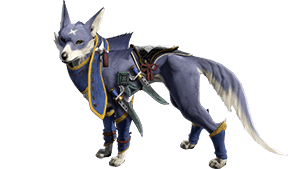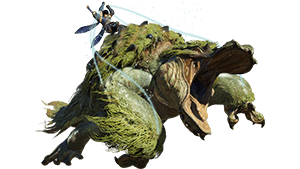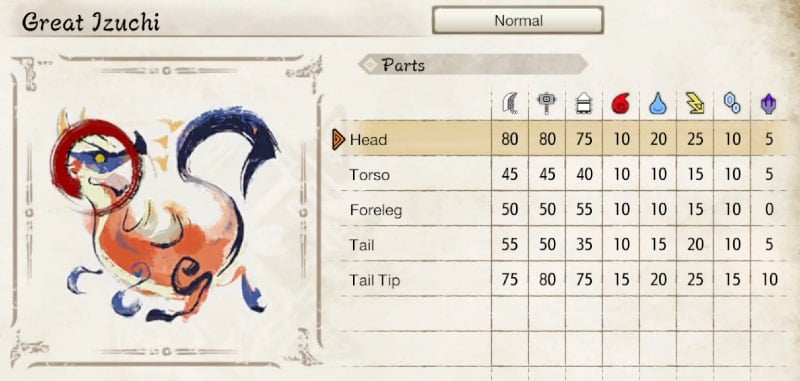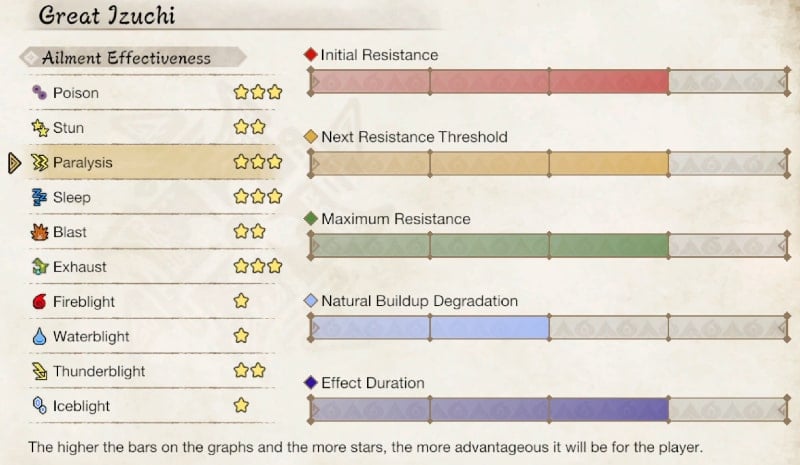Combat for Monster Hunter Rise (MHR or MHRise) contains information regarding basic and advanced features for the combat system of the game. These include tips regarding fighting monsters, exploration, interaction, a basic understanding of the controls for Monster Hunter Rise, and basic guides on familiarizing the various Weapons that are available in the game.
- See Weapon Mechanics and Silkbind Attacks for details on the many weapon categories and their special skills.
Monster Hunter Rise Combat
The Wirebug

In Monster Hunter Rise, a new combat feature is introduced which is the Wirebug. Not only does it feel great to be used for movement, but it also introduces powerful new weapon attacks as well. All actions that require the use of the Wirebug consumes the Wirebug Gauge, but the number of gauges required and the ensuing cooldown time differ per action. Listed below are the featured actions that can be done with the Wirebug:
- Wiredash: A quick forward dash that even lets you move through the air. It's not just a great way of reaching your objective, but it can be chained into attacks and aerial dodges as well, so it's very helpful during hunts.
- Wall Run: This can be performed by executing a Wiredash towards a wall. You'll keep climbing even the steepest of slopes until your stamina is depleted.
- Wirefall: An evasive move that can be used when you're pushed over or knocked back. It allows you to regain your footing quickly, so that you can avoid follow-up attacks from monsters.
- Silkbind Attack: A special attack using the Wirebug. All 14 weapons have their own unique Silkbind attacks. It can be performed with your weapon drawn, making utmost use of the characteristics of each weapon.
Supportive Buddies

In Monster Hunter Rise, the player hunter is accompanied by Buddies on their hunts: Palicoes, and Palamutes. Take note that in single-player mode, you can take any combination of two Buddies with you. But in multiplayer mode, you can only bring along one Buddy, so choose wisely!
Palamutes are a new type of Buddy that will join you on your hunts. They will synchronize their attacks with you, and they will even let you ride on their backs. As long as you're riding a Palamute, you will not consume any stamina, so you can run across the fields to your heart's content. You can even use some items and recover health while on the move -and guess what? You can pet them!
Palicoes make their triumphant return in this new Monster Hunter series, and they will provide the player with all kinds of various and unique support tactics, while still providing that felyne charm we all know and love.
Wyvern Riding

Have you ever wanted to use a Rajang as a mobile lightning cannon? In Monster Hunter Rise, you can! Wyvern Riding is a new mechanic debuting in Rise which allows a Hunter to mount a monster and unleash its arsenal of deadly moves on other monsters in the vicinity.
Performing Silkbind attacks on monsters can cause them to get tangled in the silk and enter a mountable state. The hunter can then use their Wirebug like reins and ride the monster around, perform several attacks or simply launch the monster into a wall to topple it, setting it up for further punishment.
Take advantage of this new mechanic and turn the tide of battle in your favor. The enemy of your enemy, is (temporarily) your friend!
Combat Basic
Finding the Monster
The first step to defeating any monster is finding out where it is. Unlike in previous games, Monster Hunter Rise immediately makes the position of each monster visible on the player's map at the beginning of each quest. From there, it's simply a matter of getting to the monster.
Dodging and Blocking
No matter how tough your armor is, monster attacks hit hard. Dodging and blocking are key to your continued survival while on a hunt. The basic dodge roll costs a bit of stamina and is primarily used to get out of the way of danger. It does have an extremely brief invulnerability window the very moment you press the button, and this window can be extended through armor skills. Hunters also have a panic dive. When sprinting away from a monster, hunters will run slightly faster and use more stamina, but if you dodge during this, you perform a panic dive. The dive has complete invulnerability from start to finish and is crucial for dodging large sweeping attacks.
The other option is blocking. The only weapons that can block are the Sword & Shield, the Lance, the Gunlance, the Charge Blade, the Greatsword, and the Heavy Bowgun when it has a shield attached. When you block an attack, it costs you stamina and, depending on the size of the attack, health. Generally, the larger, more grandiose the attack, the more damage and stagger is going to get around your block. This chip damage can be lessened by certain armor skills. The Lance and Gunlance have the best block, followed by the Sword & Shield, the Heavy Bowgun, and the Charge Blade with the Greatsword in last. The Charge Blade and Greatsword have the added penalty of sharpness loss when they block.
Monster Weak Spots
Every monster has a weak spot. The usual suspect is the head, but a monster's weak spot can be anything from its wings, to its tail or even the inside of its mouth! When you hit a monster, and the numbers are orange, that means you are hitting a weak spot. On the flipside, if you hit a monster and purple numbers appear, it means you are hitting a part resistant to damage. Remember which parts are tough and which are soft and plan your attacks accordingly. Note: It's best to use a non-elemental weapon when testing for a weak spot as the element might give orange/purple numbers even if you hit a weak/tough spot.
Elemental Weakness 101
Every monster is weak to one of the five elements. However, what element a monster is weak to might not be apparent or even be counter intuitive. For example, the fire breathing Rathalos is weak to the dragon element, and not water as you would assume. When experimenting to find out a monster's weakness purple damage numbers mean it resists the element, white numbers means it has neutral relationship to that element, and orange means it's weak. Another way to check is to look at the elemental resistances on the armor that you can make from the monster. Often, it will mirror the monster's own resistances.
Status Effects 101
Status effects are things like poison or paralysis. When attacking a monster with a weapon with a status effect, there are a few things to keep in mind. First, status is inflicted when a certain threshold of status damage is met. Once the damage threshold is met, the abnormal status is triggered and the threshold is reset to zero. There are some armor skills that can increase the amount of status effect damage you deal per hit. Second, monsters will gain resistance to a status each time it is triggered. For example, once a monster has been paralyzed and recovers, the damage threshold for inflicting paralysis will increase, meaning it will take longer for it to be paralyzed again. Lastly, some monsters are immune to certain status effects. If a monster is spewing poison, it is probably immune to poison. You can check your Hunter's Notes to see what status effects a monster is resistant to.
How do you break parts in Monster Hunter Rise?
Large Monster body parts in the Monster Hunter franchise each have their own individual health pools. When it's health is completely depleted, the monster part will be broken. There are some cases where a broken body part causes Monsters to take more damage or breaking specific parts hinders the Monster from performing certain abilities, however, the main reason you want to be breaking monster parts in Monster Hunter Rise is to earn part-specific rewards. Many rare materials come from breaking Monster parts, such as mantles that can only be obtained (with a low chance) from breaking monster heads or backs. Each monster has different hitzones, and each hitzone takes different amounts of damage from each damage type. For example, Diablos' Horns take significantly more damage from blunt damage, while it's Tail takes significantly more from sever damage.
Some monster parts can even be broken off and carved separately from their monster bodies. These include almost all monster tails that can only be cut off with sever damage and the Barroth Scalp which can only be broken off using blunt damage on Barroth's head. Almudron's tail also has a special property in that hunters must first break the part before being able to sever it.
Offensive Tactics
No matter how elaborate your plan is, every hunt will come down to you hitting a monster with your weapon until it dies. While every weapon has its own abilities, movesets, and playstyle, there are several universal constants to consider for all hunters when going on the offensive. These include managing distance, and when to fight defensively, when to fight with moderation and when to go all out.
Managing your distance is important to avoid attacks while still being able to attack yourself. The exact distance will vary from monster to monster and from weapon to weapon. Some monsters will force you to stay far away from them, making you run in to get a few hits and then run away. Other monsters will punish you for staying away so you should make use of the blind spot near their feet. You also have to take into consideration your weapon. Ranged weapons will want to stay out of reach of the monster but within the optimal range of their shots. Nimble weapons will want to dash in and out of combat, while weapons with good blocking ability will want to stay right next to the monster no matter what.
Knowing when and how to fight is also important. When the monster is calm and focusing someone else, you want to fight moderately; getting some attacks in while still ready to block or dodge. Once monsters have taken enough damage, they will enter a rage mode. In this mode they are faster, hit harder, and use new moves. When a monster is in rage mode, or is focusing you, you want to fight defensively; sheathe your weapon to stay mobile, focus on dodging and blocking, and only attack if you are 100% sure you aren't about to get knocked into next week by the monster. When a monster has used up all of its stamina, it will go into an exhausted state. It will be slower, less aggressive, and some of its special attacks will fail. When a monster is exhausted or knocked down, this is the time to go all out. Unleash everything you have on the monster and don't stop until it is ready to attack again. Remember this, master the flow of combat, and no monster will be able to stand against you.
Food
Food plays an important part in hunting monsters. Always be sure to eat before heading out to do anything. Meals can raise your max health and stamina, which can be invaluable when facing off against monsters. When deciding which dangos to get, be sure to read each of their effects and choose a combination that will give you the effects you think will help you the most. Also, don't forget to check out the daily special each time, as they often possess special effects that can make your hunts much more lucrative!
Monsters Near Death
When a monster is near death, they will try to run away from the hunters. They will start limping as they head back to their home and attempt to sleep and heal. Flying monsters tend to go to high up areas, while aquatic monsters will go by water, and subterranean monsters will go to caves. Attacking the monster while it's running can stagger it and force it to continue to fight, while letting it run will allow you to recover and set up an ambush while it sleeps. Limping monsters are also ready to be captured.
How do I increase my maximum Health in MHR?
In Monster Hunter World, all hunters had to do was drink a Max Potion or Ancient Potion to increase their maximum HP pool and maximum Stamina with the latter consumable. This has been changed in Monster Hunter Rise, however, with these items only restoring lost HP and Stamina. To increase max HP, hunters will now have to collect Spiribirds found scattered across each map. There are 5 Spiribird types: Green increases maximum HP, Yellow increases maximum Stamina, Red increases attack power, Orange increases defense, and Prism increases all of the above to it's maximum value. The Prism Spiribird is only found in the Arena and Forlorn Arena. How much each Spiribird provides depends on which Petalace you have equipped. Some Petalaces provide more HP, some are more attack boost-oriented, while others give a well-rounded set of stats. You can find Spiribirds in each locale by setting your map to show Endemic Life or using the Buddy Skill Sniff 'em out! A random assortment of Spiribirds can also be found when attacking grass patches.
How do I get out of Stun in Monster Hunter Rise?
Hunters can get stunned by monsters by being hit multiple times in a short time span. While stunned, hunters will be unable to perform any actions and will be very vulnerable to monster attacks. Players can get out of being stunned quicker by continually hitting their movement keys or moving their joystick back and forth. Hunters will also be snapped out of being stunned when hit with any attack. This attack does not have to deal damage or be from monsters; allies, whether other online players, followers or even your own Buddies can help you get out of stun with a single attack. NPC followers and Buddies will actually come to you most of the time to snap you out of a stun.
Advanced Tips
Using the Environment
In addition to your weapons, items and slinger, you can also use the environment to gain the upper hand in battle. Climbing ledges and leaping off walls can let you land valuable jumping attacks, and keep you out of reach of the monster. Insects and small animals can be struck to provide diffrent effects such as healing, blinding light, or paralyzing gas. Knowing what to look for in the environment, and how to best use it, is as important a skill as knowing how to fight with your chosen weapon.
Enviromental Hazards
While the environment can help you in numerous ways, it can also be dangerous. Hunters can get caught up in a landslide, or paralyzed by gas just as easily as the monsters. Additionally, Hunters have to worry about overheating, freezing, and lava. In areas with extreme heat, like the desert during the day or a volcano, hunters will take damage over time as they cook alive. Cool Drinks will stop this, but only for a time. In areas with extreme cold, like deserts at night or in tundras, a hunter's max stamina will decrease far faster than normal as their limbs begin to freeze. Hot Drinks will prevent this, but not for long. Lastly, lava is, unsurprisingly, very hot. Merely being near it will drain a hunter's health very fast, and there isn't an item to prevent it. All of these ailments can be prevented by certain armor skills. Knowing what hazards you will face and being prepared to counter them with items or skills is crucial for hunting in extreme environments.
Teamwork
While the entire game can be played solo, teaming up with your fellow hunters is a main feature and knowing how to work with them is important for surviving the more difficult hunts. Be mindful of your attacks. While you can not damage your teammates, you can stagger them, interrupting whatever they were doing, and even send them flying. Avoid clustering up, if the monster decides to attack one of you, it will hit all of you. Bring items that can heal your teammates, such as lifepowder or recovery ammo. They can save your friend's life, and lives are shared among all players, so it helps you too. Pick your equipment with your teammates in mind. Have everyone stack poison or paralysis, use support oriented weapons like the Hunting Horn or Light Bowgun, or mix cutting and blunt weapons. And lastly, talk with your team. Share monster info, talk strategy, trade favorite item gathering locations, show off your cool armor and weapons to each other, and cheer each other on. It will make you a better hunting party and increase everyone's enjoyment.
Getting Monsters to do Your Work for You
The monsters you hunt are all part of a complete ecosystem, and just like real life ecosystems, there are predators and there are prey. Monsters have their own territories, and they don't like other monsters being in them. If you bring a weaker monster into the territory of a stronger one, there is a good chance that the stronger one will attack the weaker one. The effectiveness of this varies, but often monsters will deal more damage to each other than a hunter could dish out. The downside to this is that you now have two angry monsters to avoid, but the damage is often well worth the risk.
Sleep Bombing
A common strategy among hunters is for one or more people to bring a weapon with the status effect sleep. Once a monster has been put to sleep, the next attack will deal greatly enhanced damage and wake the monster up. To get the most out of this increased damage, hunters will bring large barrel bombs with them on the hunt. Everyone on the team will set their bombs up on top of the monster's weak point, and then the hunter with the highest damage attack, usually the Greatsword's charge attack, will set off the bombs. This strategy requires good teamwork among hunters and a fair amount of preplanning, however, the truly massive damage is well worth it.
Trapping Monsters and Follow Ups
Trapping monsters is a key tactic when hunting. Certain items in the environment can be used or you can bring premade pitfall and shock traps to set up where ever you need one. When deciding what trap to use, you need to consider the monster. Electric monsters will often resist the shock trap and some might even get stronger from it. Nimble and cunning monsters will escape the pitfall trap faster, and some won't even fall into it. Pitfall traps take a bit longer to set up than shock traps, but they bring the monster closer to the ground which allows for easy attacks on hard to reach limbs.
Once you have determined what trap to use, you need to decide when and where to set it up. The ideal trap is mid combat. Set it up when the monster isn't focusing you, and then use yourself for bait. If the monster hasn't noticed you, and eats meat, you could set up the trap and put meat on it. Then find a place to hide while you wait for the monster to notice. Bonus points if you poison the meat ahead of time. Unless you can set it up in the path of the monster, never use a trap when the monster is fleeing. It will almost always go far away from the trap resulting in nothing but a wasted trap and a frustrated hunter.
Now that the monster has fallen into the trap, there are a few things you can do. You could simply start wailing on with your weapon without further ado. This is useful if you had a certain body part you wanted to break. Another option is to bring large barrel bombs with you, set them up next to the monster's weak point and set them off for massive damage. The last option is capturing the monster. A monster that is near death and stuck in a trap can be taken out permanently with two tranq bombs or tranq shots. Capturing a monster doesn't let you carve the monster for materials, but it does give you bonus materials in the quest rewards and these materials are often rare parts. Certain quests also require you to capture a monster, rather than kill it.
Fundamental Tips
Restoring Health
You can restore lost health by using potions. If you have some honey, you can combine it with a potion to make a mega potion, which restores even more health.
Stamina
Dashing, evading, and performing certain actions will deplete your stamina. Your maximum stamina will also gradually decrease over time, but it can be maintained by eating well-done steaks or rations.
Crouching and Camouflage
Press the dodge button while standing still to crouch. Crouching in brush grants you camouflage so you can hide from monsters.
Sharpness
Close-range weapons gradually lose sharpness with each attack. As a weapon's sharpness level falls, its attacks are more likely to be deflected, but you can restore its sharpness with whetstones.
Damage Types & Monster Hitzones
Damage Types in Monster Hunter Rise are the different damage categories of the game. Each weapon predominantly possesses a Physical damage component(also commonly referred to as Raw) which is further divided into one of three types: Severing, Blunt and Projectile. Certain weapon attacks may also deal a different damage type than its primary. Weapons may also possess a secondary property that deals an Elemental damage type, or inflict a Status Ailment. These primary and secondary properties tie into a Monster's weaknesses and resistances.
In Monster Hunter Rise, every Monster has several different body parts, also known as Hitzones, with varying susceptibility to the various damage types. Understanding a Monster's Hitzone values is the key to exploiting their weaknesses.

The example above details the Hitzone Values per damage type on the Monster's various parts. Using a Physical Blunt damage weapon such as a Hammer, attacking the Monster's head and tail tip will prove the most effective. Conversely, attacking its torso with the same weapon will yield the least damage.
Using an Elemental Weapon will apply the weapon's Physical Damage component, as well as deal additional Elemental Damage as long as the Elemental Hitzone Value is above 0. For instance, using a Thunder Elemental Hammer on this Monster's head or tail tip will yield the best results. Any parts that have an Elemental Hitzone Value of 0 will negate the Elemental damage component entirely, but still take into account the Physical component.
A Monster's parts are generally considered vulnerable to a particular damage type if its Hitzone value is 45 or above for Physical, or 20 and above for Elemental. Check out the individual pages for each Monster for info on their Hitzones.
In addition to the primary and secondary Damage Types, there are also two Types that are commonly referred to as True Damage and Parts Damage.
True Damage is any Damage that is not modified by a Monster's Body Part Multipliers. Sources include Gunlance shells, Bowgun Sticky Ammo, and Bomb Items such as the Barrel Bomb.
Parts Damage is dealt whenever a breakable part of a Monster's body receives Damage, and contributes towards breaking that individual part. It is not represented by an onscreen number. Breaking a Monster's body parts raises their Body Part Multipliers against damage, saps the Monster's Stamina, and may limit the attacks that it can do. Parts Damage can be modified with the Partbreaker Skill.
Physical Damage
Physical Damage, also known as "Raw" is the primary component of a Weapon's damage. This is further subdivided into three types, against which Monster Body Parts have varying resistances.
 Severing Damage
Severing Damage
Sword slashes, lance thrusts, etc: Can be used to cut the tails off certain monsters.
 Blunt Damage
Blunt Damage
Shield bashes, hammer smashes, etc: Reduces Monster Stamina and stuns them if hit on the head.
 Projectile Damage
Projectile Damage
Projectiles, Arrows, Bowgun: Special properties depending on the attack.
Elemental Damage
Elemental Damage is a secondary property that applies additional elemental damage depending on a Monster's resistances. This can take the form of one of five elements in the game. Certain weapons can possess more than one Elemental Damage type.
Status Ailments & Damage
Status Ailments are special effects that can be inflicted on Monsters by weapons that possess one of these properties. Unlike Elemental Damage, Status Ailments are not activated immediately, but instead need to be built up by inflicting Status Damage. Each monster has varying resistances and thresholds for Status Ailments.

The example above displays the Monster's resistances to each Ailment. The Monster has different values that affect the effectiveness of each Ailment, as well as the difficulty of triggering the Ailment's effects.
- Initial Resistance - Denotes the Monster's innate resistance to the particular Status Ailment. Triggering the ailment requires dealing enough Status Damage to overcome this threshold. The higher the bar, the easier this is to do.
- Next Resistance Threshold - Denotes the amount of Status Damage required to trigger the next instance of the ailment. Note that triggering an ailment's effects will reset Status Damage build-up to 0 until the Monster has recovered. This graph shows how easy or hard it is to trigger the next instance.
- Maximum Resistance - Denotes a Monster's gradual tolerance build-up for the Status Ailment. The higher the bar, the more times you can inflict the Ailment on the Monster throughout the hunt.
- Natural Buildup Degredation - Denotes the decay of Status Damage build-up if a Monster is not dealt Status Damage consistently in a while. The higher the bar, the slower the build-up decays.
- Effect Duration - Denotes the length of time a Status Ailment is in effect once triggered. This is replaced by Total Damage for Poison and Fireblight, Damage for Blast and Stamina Loss for Exhaust.
In addition to Weapon effects, Status Ailments can also be inflicted by using the Hunting Helper creatures found throughout hunts. Check out the individual pages for each Monster for details on their Status Ailment weaknesses.
 Anonymous
Anonymous

I love how the "find the monster" section talks about scoutflies when they arent even in this game lol
1
+11
-1